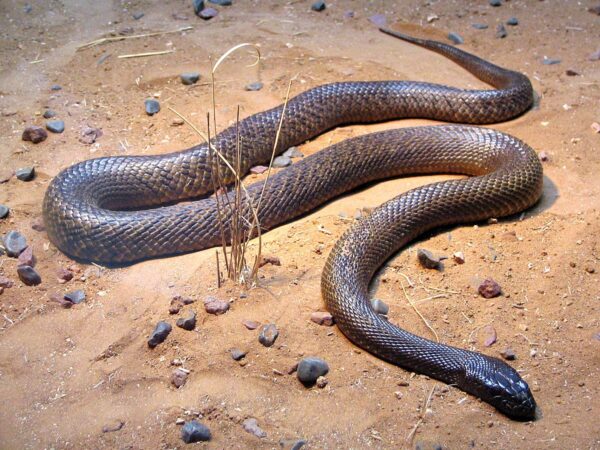 The title of the most venomous snake in the world belongs to the Inland Taipan (Oxyuranus microlepidotus), also known as the �fierce snake� or �small-scaled snake.� Native to Australia, this reclusive serpent is not only the most venomous snake on Earth but also one of the most enigmatic. Despite its deadly potential, the Inland Taipan is rarely encountered in the wild and has a surprisingly shy and non-aggressive disposition.
The title of the most venomous snake in the world belongs to the Inland Taipan (Oxyuranus microlepidotus), also known as the �fierce snake� or �small-scaled snake.� Native to Australia, this reclusive serpent is not only the most venomous snake on Earth but also one of the most enigmatic. Despite its deadly potential, the Inland Taipan is rarely encountered in the wild and has a surprisingly shy and non-aggressive disposition.
Scientific Classification
- Common Name: Inland Taipan
- Scientific Name: Oxyuranus microlepidotus
- Family: Elapidae (the same family that includes cobras and coral snakes)
- Conservation Status: Least Concern, but rarely seen due to its remote habitat
The Inland Taipan�s venom is extraordinarily potent�the most toxic of any snake known to science. It is estimated that a single bite contains enough venom to kill over 100 adult humans or 250,000 mice. The key component of its venom is a cocktail of neurotoxins, procoagulants, and myotoxins, which:
- Paralyze the nervous system
- Cause massive internal bleeding
- Lead to muscle tissue destruction
Median Lethal Dose (LD??) tests conducted on mice (a standard measurement of venom toxicity) have shown the Inland Taipan�s venom to be 50 times more toxic than the Indian cobra�s and nearly 10 times more toxic than a rattlesnake�s.
Despite its fearsome reputation, the Inland Taipan is not aggressive and tends to avoid human contact. It inhabits the semi-arid regions of central Australia, especially the black soil plains of Queensland and South Australia. This remote and harsh environment has limited human encounters, which, in turn, contributes to the snake�s relatively low profile compared to other dangerous reptiles.
When threatened, the Inland Taipan prefers to flee. Bites are extremely rare in the wild, and nearly all recorded envenomations have occurred in controlled environments like snake-handling or venom extraction facilities.
The Inland Taipan is a specialist predator that primarily feeds on mammals, especially native rodents like the long-haired rat. Its hunting method is swift and efficient�using its lightning-fast strike to deliver multiple bites in rapid succession, often killing its prey in seconds. This swift and lethal approach ensures the prey has little chance to fight back, minimizing the risk to the snake.
Though the venom is deadly, antivenom for Inland Taipan bites does exist, developed from the venom of closely related snakes. Prompt medical attention and administration of antivenom can prevent death and significantly reduce long-term effects. However, due to the snake�s remote habitat, accessing emergency medical care in time could be challenging for a victim bitten in the wild.
While the Inland Taipan holds the record for venom toxicity, several reasons explain why it�s not considered a major threat:
- Remote Habitat: It lives in sparsely populated, arid regions.
- Non-Aggressive Nature: It does not seek confrontation with humans.
- Reclusive Behavior: The snake spends much of its time in deep cracks in the earth or under cover, avoiding exposure.
In contrast, snakes like the saw-scaled viper, cobra, and Russell�s viper are responsible for far more human fatalities annually due to their broader distribution and proximity to populated areas.
Though not endangered, the Inland Taipan�s elusive nature makes it difficult to study in the wild. It has become somewhat of a mythical figure in herpetology�fascinating researchers and snake enthusiasts alike. Its venom is also of great medical interest, with research ongoing into its potential uses in treating blood pressure and clotting disorders.
The Inland Taipan is a paradox: the most venomous snake in the world, yet one of the least dangerous to humans due to its reclusive nature. It is a testament to the diversity and complexity of Australia�s unique wildlife. Often misunderstood or sensationalized, the Inland Taipan is more of a scientific marvel than a menace�an apex example of evolutionary specialization and ecological balance.
While its bite could be lethal within an hour without treatment, the reality is that you�re more likely to win the lottery than to encounter an Inland Taipan in the wild. Still, its legacy as Earth�s most venomous snake ensures it a permanent place in both the annals of science and the human imagination.







